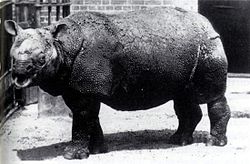 The Javan Rhinoceros (Sunda Rhinoceros to be more precise) or Lesser One-horned Rhinoceros (Rhinoceros sondaicus) is a member of the family Rhinocerotidae and one of five extant rhinoceroses. It belongs to the same genus as the Indian Rhinoceros, and has similar mosaicked skin which resembles armor, but at 3.1–3.2 m (10–10.5 feet) in length and 1.4–1.7 m (4.6–5.8 ft) in height, it is smaller. (In fact, it is closer in size to the Black Rhinoceros of the genus Diceros.) Its horn is usually less than 25 cm (10 inches), smaller than those of the other rhino species.
The Javan Rhinoceros (Sunda Rhinoceros to be more precise) or Lesser One-horned Rhinoceros (Rhinoceros sondaicus) is a member of the family Rhinocerotidae and one of five extant rhinoceroses. It belongs to the same genus as the Indian Rhinoceros, and has similar mosaicked skin which resembles armor, but at 3.1–3.2 m (10–10.5 feet) in length and 1.4–1.7 m (4.6–5.8 ft) in height, it is smaller. (In fact, it is closer in size to the Black Rhinoceros of the genus Diceros.) Its horn is usually less than 25 cm (10 inches), smaller than those of the other rhino species.
Once the most widespread of Asian rhinoceroses, the Javan Rhinoceros ranged from the islands of Java and Sumatra, throughout Southeast Asia, and into India and China. The species is critically endangered, with only one known population in the wild, and no individuals in captivity. It is possibly the rarest large mammal on earth,[5]:21 with a population of as few as 40 in Ujung Kulon National Park on Java in Indonesia. A second population in Cat Tien National Park in Vietnam was confirmed as extinct in 2011.[6] The decline of the Javan Rhinoceros is attributed to poaching, primarily for their horns, which are highly valued intraditional Chinese medicine, fetching as much as $30,000 per kilogram on the black market.[5]:31 Loss of habitat, especially as the result of wars, such as the Vietnam War, in Southeast Asia, has also contributed to the species's decline and hindered recovery.[7] The remaining range is within one nationally protected area, but the rhinos are still at risk from poachers, disease and loss of genetic diversity leading to inbreeding depression.
The Javan Rhino can live approximately 30–45 years in the wild. It historically inhabited lowland rain forest, wet grasslands and large floodplains. The Javan Rhino is mostly solitary, except for courtship and child-rearing, though groups may occasionally congregate near wallows and salt licks. Aside from humans, adults have no predators in their range. The Javan Rhino usually avoids humans, but will attack when it feels threatened. Scientists and conservationists rarely study the animals directly due to their extreme rarity and the danger of interfering with such an endangered species. Researchers rely on camera traps and fecal samples to gauge health and behavior. Consequently, the Javan Rhino is the least studied of all rhino species. Two adult rhinos with their calves were filmed in a motion-triggered video released on February 28, 2011 by WWF and Indonesia's National Park Authority, which proved that it is still breeding in the wild.
Taxonomy and naming
The first studies of the Javan Rhinoceros by naturalists from outside of its region took place in 1787 when two animals were shot in Java. The skulls were sent to the renowned Dutch naturalist Petrus Camper, who died in 1789 before he was able to publish his discovery that the rhinos of Java were a distinct species. Another Javan Rhinoceros was shot on the island of Sumatra by Alfred Duvaucel who sent the specimen to his stepfather Georges Cuvier, a famous French scientist. Cuvier recognized the animal as a distinct species in 1822, and in the same year it was identified byAnselme Gaëtan Desmarest as Rhinoceros sondaicus. It was the last species of rhinoceros to be identified.[9] Desmarest initially identified the rhino as being from Sumatra, but later amended this to say his specimen was from Java.[3]
The genus name Rhinoceros, which also includes the Indian Rhinoceros, is derived from Greek: rhinomeaning nose, and ceros meaning horn; sondaicus is derived from sunda, the biogeographical region that comprises islands of Sumatra, Java, Borneo, and surrounding smaller islands. The Javan Rhino is also known as the Lesser One-Horned Rhinoceros (in contrast with the Greater One-Horned Rhinoceros, another name for the Indian Rhino).
There are three distinct subspecies, of which only one is still extant:
- Rhinoceros sondaicus sondaicus, the type subspecies, known as the Indonesian Javan Rhinoceros, once lived on Java and Sumatra. The population is now confined to as few as 40 animals in the wild, Ujung Kulon National Park on the western tip of the island of Java. One researcher has suggested that the Javan Rhino on Sumatra belonged to a distinct subspecies, R.s. floweri, but this is not widely accepted.[10][11]
- Rhinoceros sondaicus annamiticus, known as the Vietnamese Javan Rhinoceros or Vietnamese Rhinoceros, once lived across Vietnam, Cambodia, Laos and into Thailand and Malaysia. Annamiticus is derived from the Annamite Mountain Range in Southeast Asia, part of this subspecies's range. In 2006, a single population, estimated at fewer than 12 remaining rhinos, lived in an area of lowland forest in the Cat Tien National Park in Vietnam. Genetic analysis suggested that the this subspecies and the Indonesian Javan Rhinoceros last shared a common ancestor between 300,000 and 2 million years ago.[11][12] The last individual of this population was shot by a poacher in 2010.[13]
- Rhinoceros sondaicus inermis, known as the Indian Javan Rhinoceros, once ranged from Bengal to Burma, but is presumed to have gone extinct before 1925.[14] Inermis means unarmed, as the most distinctive characteristic of this sub-species is the small horns in males, and evident lack of horns in females. The original specimen of this species was a hornless female. The political situation in Burma has prevented assessment of the species in that country, but its survival is considered unlikely.

Tidak ada komentar:
Posting Komentar